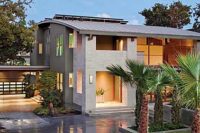
Italian architect and designer Aldo Cibic and
engineered stone manufacturer Santamargherita conceived the project “Stone in
Blossom” during the 2009 Marmomacc stone fair in Verona, Italy.
Santamargherita’s “Second.Life” line of recycled engineered stone is a key
element of the design.
Over the years, Italian architect and designer Aldo Cibic has developed a reputation for creating distinctive, yet comfortable environments - including homes, public spaces and a broad range of home furnishings. With a design style that emphasizes “more with less,” Cibic’s work strives to create environments where people can socialize while also interacting with the surrounding landscape.
These concepts were in place for a recent collaboration between Cibic and Italian engineered stone manufacturer Santamargherita during the 2009 Marmomacc stone fair in Verona, Italy. As part of the event’s “Marmomacc Meets Design” program - which promotes interaction between the stone industry and the design community - Santamargherita and Cibic conceived the project “Stone in Blossom.” The design was executed as part of Santamargherita’s booth layout, and it is an “indoor garden” environment with a layout that intends to stimulate personal interaction. Cibic utilized a new recycled engineered stone product from Santamargherita as a key element of the design.

The design was executed as part of Santamargherita’s
booth layout, and it is an “indoor garden” environment.
The project used products from the “Argilla” variety of Santamargherita’s “Second.Life” line of recycled engineered stone, and panels were used as both flooring and wall cladding. The darker pieces are sandblasted and slightly repolished, while the lighter pieces are actually the back-sides of the finished pieces.
Moreover, since consumers usually associate engineered stone with countertops, this application as wall cladding and flooring was a new concept in the use of the product.

The project used products from the “Argilla” variety
of Santamargherita’s “Second.Life” collection, and panels were used as both
flooring and wall cladding.
Santamargherita’s Second.Life collection includes recycled quartz, porcelain, glass and mirrors. It has the same technical characteristics as traditional quartz surfacing, and can be polished using the same methods.
“Second.Life is an idea, a name, a new brand,” stated Santamargherita. “With this new product line, Santamargherita materializes an ambitious plan - manufacture engineered stone with up to 95% recycled content. At Santamargherita, we have always been committed to environmental responsibility as an integral part of our business. Thanks to the continual research by our laboratories, Second.Life reflects the will to preserve the planet and the awareness that the resources to do it are readily available. Our new product line gives a second life to materials that in the past have had different forms and applications. We recycle these materials by incorporating them in the manufacturing process using the latest technology to produce an engineered stone of high aesthetic beauty and value.
“With Second.Life, Santamargherita gives professionals, builders and private consumers an engineered stone line meeting several criteria of the LEED building system,” the company continued. “Our contributions to the achievement of certification for sustainable building are according to U.S. Green Building Council standards.”

